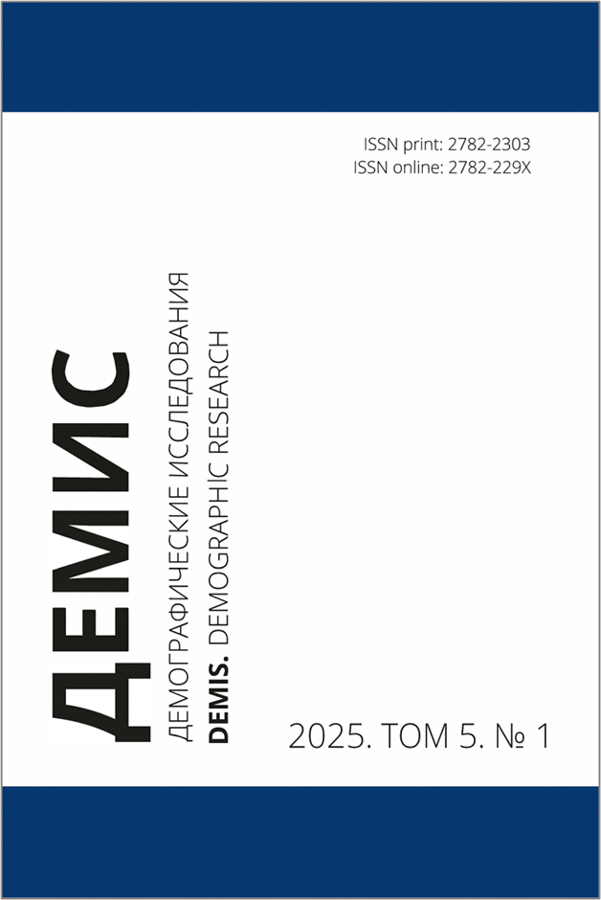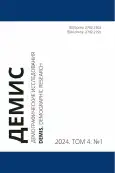Vol 4, No 1 (2024)
Demographic and migration theory
A General Theory of Population Aging and Its Impact on Socio-Economic Development
Abstract
Population aging is becoming one of the discussed topics not only in Vietnam but all over the world and is one of the most important social transformation phenomena of the 21st century. This process will affect to most areas of social life such as the labor market, finance, demand for goods and services, education, social security and health care for the elderly, etc. Research on aging, especially in a developing country like Vietnam, has become more urgent than ever, when the aging rate is fast but the average income is low and the social security budget is tight. Therefore, population aging can slow down the economic growth and increase the burden on the budget, even affecting social stability. This article analyzes the current situation and aging trends in Vietnam. Next, it focuses on clarifying the general theory of the mechanism of population aging and pointing out the impact of population aging on socio-economic development. Quantifying the impact of aging on socio-economic growth is very complex, requiring in-depth, multi-disciplinary, multi-field and multi-dimensional research. This analysis has reviewed some reliable assessment methods in the world as well as in Vietnam on aging. The results suggest a more multifaceted perspective on aging, referring to the consideration of the age structure of the population in development. At the same time, research on aging requires the participation of scientists, policymakers, etc. to effectively respond to an aging society.
 8-22
8-22


Mathematical Models of Migration Balance and Migration Attitudes in Armenia
Abstract
 23-39
23-39


Demographics of the labor market
Demographic Characteristics of Labor Resources Formation and Use in the Largest Cities of Russia in 2019–2021
Abstract
 40-54
40-54


Features of Distribution and Use of Foreign Labor in the Siberian Federal District
Abstract
 55-64
55-64


Demographic regional studies
Labour Migration and Economic Growth: A Perspective from Asia Pacific Region
Abstract
Globalization has led to significant changes in economies and societies worldwide, particularly in the Asia-Pacific region where labor migration drives economic growth. Migrant workers, valued across various sectors, play a key role in regional development by sending remittances that support families’ essential needs and entrepreneurial endeavors. Countries have simplified immigration procedures and enacted protective measures to attract and retain foreign labor, but challenges such as job displacement and balancing the rights of migrants with those of domestic workers persist. Research on the impact of labor migration on economic development in the Asia-Pacific region is crucial in addressing these complexities. Therefore, this article will focus on elucidating the theoretical foundations and practical aspects of labor migration while examining the correlation between labor migration and economic development in the countries within the Asia-Pacific region. The main purpose of the study is to elucidate the general migration context of the Asia-Pacific region and clarify it by conducting a deeper analysis of some representative countries in the region. Additionally, the study aims to elucidate the relationship between labor migration and economic development in this area. The results reveal that labor migration has a positive impact on economic growth through remittances.
 65-84
65-84


Socio-Economic and Demographic Aspects of Russian Tourism in Thailand in 2023
Abstract
 85-100
85-100


The Influence of Motivation Factors on Housing Choice of Migrants in Ho Chi Minh City
Abstract
This study aims to assess the impact of motivational factors on the housing choices of rural-to-urban migrants. The motivations leading to housing choices include migration reasons, life events, and satisfaction with housing. The author suggested a research model with three hypotheses and conducted a survey between migrant people living in Ho Chi Minh City, Vietnam to test these hypotheses. There are several notable findings in this study. Firstly, the first hypothesis was accepted as factors related to both economic and non-economic values have a positive impact on housing choices. This aligns well with the reality that the majority of individuals aged 25–45 consider this as their primary goal when migrating to the city and searching for housing. Secondly, changes in current life circumstances can lead to changes in housing choice intentions. Thirdly, a significant finding of the research is that most individuals with an intention to change their place of residence do so because they are dissatisfied with the housing conditions or prices. In this research, housing satisfaction is an even more significant factor influencing housing choice intentions than life events and economic and noneconomic values. This study has some limitations, as it is necessary to clarify other factors, because only motivation may be impossible to change housing choice intentions. It is suggested that a number of other factors, such as opportunities or migrants’ capabilities could also influence the moving intentions.
 101-115
101-115


Social demographics
Migration Behavior of Youth in the Omsk Region: Reasons, Factors, Prospects
Abstract
 116-131
116-131


The Effect of Social Assistance on Early Childbearing in Vietnam: The Role of Migration
Abstract
The study analyzes the relationships among migration, early childbearing, and child well-being social assistance within the cluster level. Using data from the Vietnam Sustainable Development Goal Indicators for Children and Women survey (SDGCW) by the General Statistics Office (GSO) and the United Nations International Children’s Emergency Fund (UNICEF) of Vietnam in the period 2020–2021, while applying Tobit models, the results show that the increase of households’ social assistance receipt will limit the likeliness of family members to make migration decisions, thereby decreasing early childbearing. The study is expected to be the basis for making implications to improve the policy system and social assistance programs aimed at minors, especially targeting the group of minor migrants with the goal of reducing early childbearing.
 132-145
132-145


Japan’s Policies to Attract and Retain International Students: Economic and Migration Approaches
Abstract
The article examines measures taken by the Japanese government, institutions and various organizations to attract and retain international students. In March 2023, the Japanese government announced its aim to increase the number of foreign students in Japan to 400 000 in ten years. Measures to attract and retain foreign talents are part of the “new capitalism” program and are consistent with the goal of internationalizing the Japanese education system, especially higher education. In particular, the article analyzes the dynamics of the number of foreign students in Japan, and lists support measures provided by the government, institutions and other organizations. It also assesses the potential for attracting and retaining international students in the context of Japan’s declining working-age population and discusses the challenges of employment and life for foreigners in Japan during and after graduation. The study showed that, although education has traditionally been one of the main directions of Japanese cultural diplomacy, in contemporary Japan attracting foreign students is also viewed as one of the ways to solve social problems and ensure sustainable economic growth. For example, it is assumed that foreign graduates of Japanese universities will partially compensate for the labor shortage in Japan, and will also play an important role in expanding Japanese business and strengthening its positions in regional and global markets. In order to attract foreign students, the government, universities and various organizations are taking comprehensive measures to provide them with support, ranging from simplifying the admission procedure, providing scholarships for study, providing extensive information support, to assisting with employment after graduation. At the same time, the study identifies the problems faced by foreigners, in particular foreign students, which significantly limit the massive influx of foreign specialists to Japan.
 146-162
146-162


Scientific life
About the III Eurasian Analytical Forum “Ethnocultural Factors of Eurasian Integration (EAF-2023)”
Abstract
 163-180
163-180


About the VI International Winter Demographic School at Lomonosov Moscow State University
Abstract
 181-190
181-190












